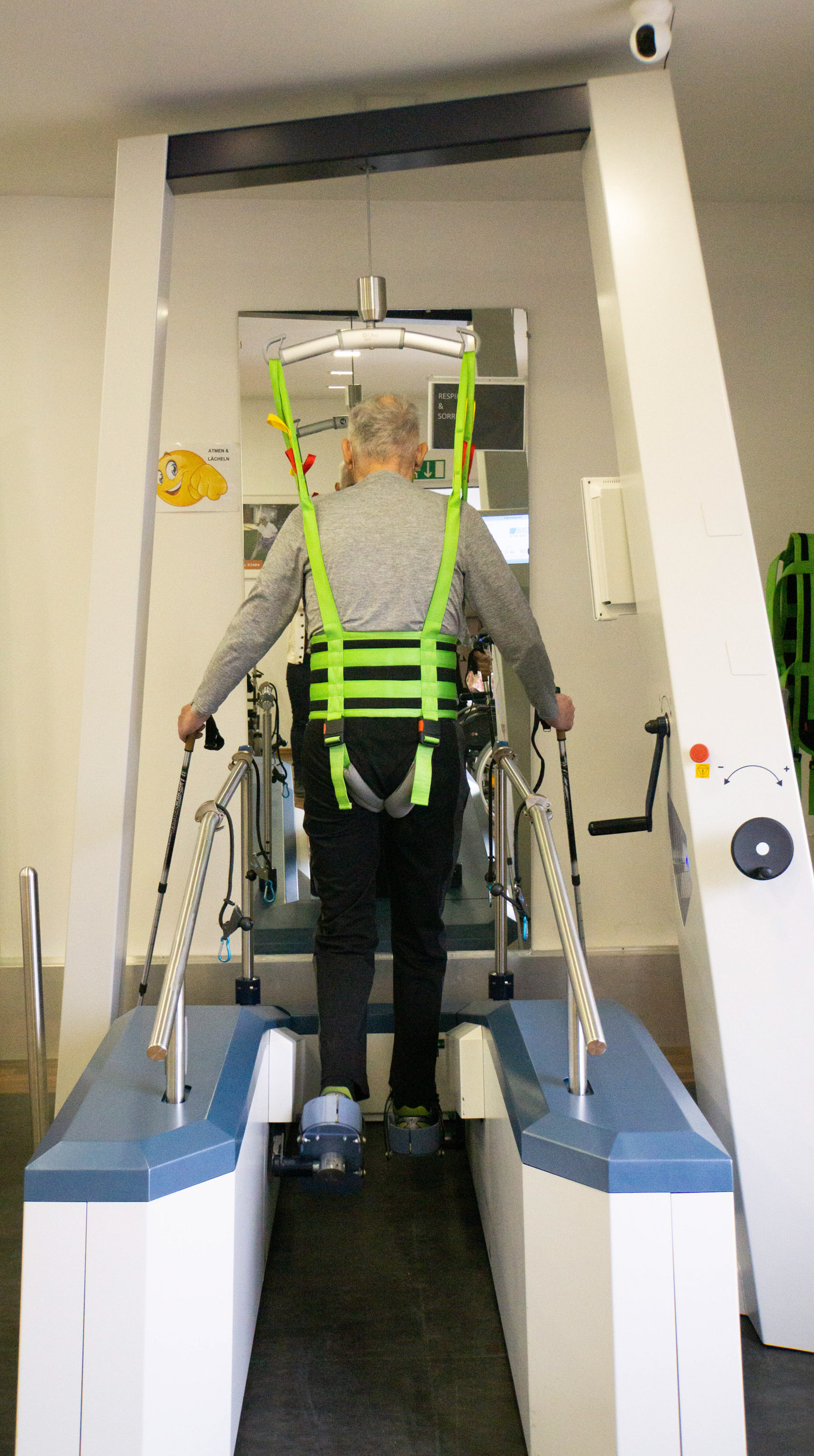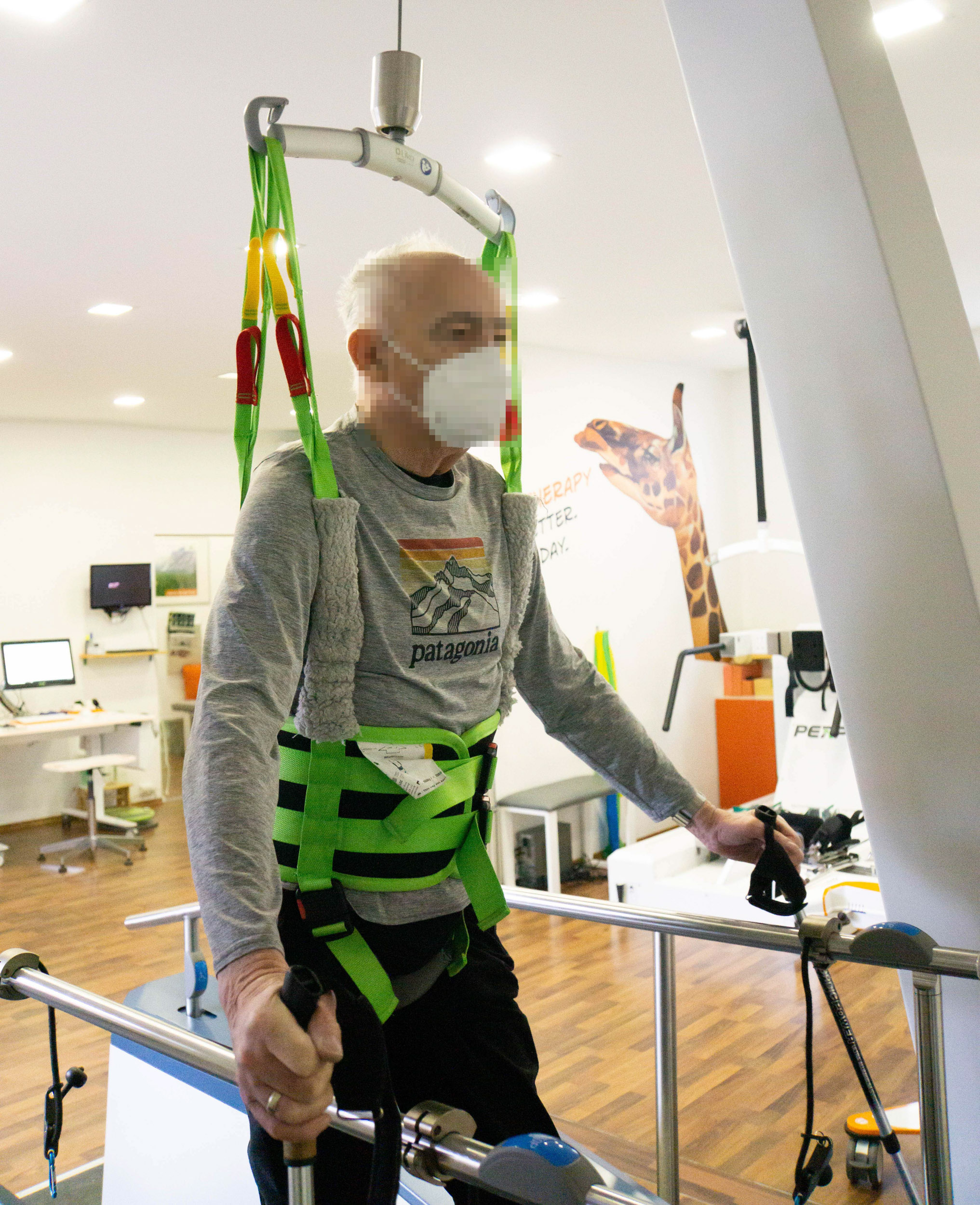
THERAPY-Magazin
Out of the wheelchair and into the mushroom forest
After incomplete paralysis, Leo R. regained mobility with THERA-Trainer lyra at HOME4MOTION. Discover his inspiring recovery journey from the wheelchair back to the forest.

Redaktion
THERAPY Magazin
After postoperative complications, the diagnosis was incomplete transverse section. Thanks to his unlimited willpower and the intensive exercise therapy, Leo R. made it back to the mushroom forest on crutches.
During a routine gastroscopy in 2018, Leo R. was diagnosed with stomach cancer. The doctors advised an operation, which went off without a hitch. However, his condition deteriorated during his stay in the normal ward. He suffered a burst stomach as well as pneumonia and had to be intubated. Leo was then in intensive care for 47 days. After waking up, he could no longer sit, walk or stand. Diagnosis: incomplete transverse section, the cause of which has not been clarified to date. This was followed by nine months of inpatient treatment in hospital and intensive rehabilitation and mobilisation in various rehabilitation facilities. However, the last stint in rehab did not produce any more significant improvements – Leo was confined to a wheelchair. Doctors also did not predict good future prospects, as at his age neurological recovery from movement limitations was unlikely. “But I didn’t want to settle for that”, says Leo. When reading a brochure, he became aware of the robotics-assisted therapy centre HOME4MOTION in Graz. He started his therapy there in August 2019 as well as conventional physiotherapy in Leoben.
Being able to look for mushrooms again
“I’m a very nature-oriented person. Even as a child, I enjoyed spending time in the forest picking berries or looking for mushrooms. Or in spring, when the pine or spruce forest is in bloom, the most beautiful thing for me was to lie down there in the moss and just enjoy life. I would love to be able to do that again”, he says enthusiastically. Leo’s support and motivation are his wife and family. “I don’t want to be a burden for anyone and I also wanted to get back on my feet myself. For me, but also for my family”, Leo continues.
That is why HOME4MOTION focuses on improving or re-learning how to walk. Walking is a complex process and requires strength, endurance and coordination of the leg muscles as well as sufficient stabilisation of the core. This is intensively trained by our gait trainer lyra as well as our gait phase trainer Omego. Through rhythmic walking and cyclical activation and relaxation of the leg muscles, adequate active movement of the legs, as well as endurance and strength of the leg muscles are improved. At the beginning, Leo still had to be pushed to the gait trainer with the wheelchair and a large part of his own weight had to be relieved. This is where the great advantage of our gait trainers comes into play, namely to perform a physiological gait pattern with partial or full weight relief. Over time, Leo could take more and more of his own weight and his general health also gradually improved so that by September Leo was already noticing improvements in his thighs and knees. Towards Christmas, he was already able to cover somewhat longer distances with the rollator. In February 2020, the first attempts at walking with crutches followed, and in the summer with walking sticks. “But it’s not like I can do without the wheelchair all together. It’s still necessary for long distances. But when I look at the difference from spring 2019, when I was wheelchair-bound, to today, the progress for me is significant”, Leo says with enthusiasm. The Omego gait trainer, which specifically addresses the gait phases of the stance and free leg phases, has also contributed to this. Exercises such as the leg press or the stepper enable the targeted training of the extensors and flexors of the knee and hip through varying demands in different games.
“I’m a very nature-oriented person. Even as a child, I enjoyed spending time in the forest picking berries or looking for mushrooms. Or in spring, when the pine or spruce forest is in bloom, the most beautiful thing for me was to lie down there in the moss and just enjoy life. I would love to be able to do that again”, he says enthusiastically. Leo’s support and motivation are his wife and family. “I don’t want to be a burden for anyone and I also wanted to get back on my feet myself. For me, but also for my family”, Leo continues.
That is why HOME4MOTION focuses on improving or re-learning how to walk. Walking is a complex process and requires strength, endurance and coordination of the leg muscles as well as sufficient stabilisation of the core. This is intensively trained by our gait trainer lyra as well as our gait phase trainer Omego. Through rhythmic walking and cyclical activation and relaxation of the leg muscles, adequate active movement of the legs, as well as endurance and strength of the leg muscles are improved. At the beginning, Leo still had to be pushed to the gait trainer with the wheelchair and a large part of his own weight had to be relieved. This is where the great advantage of our gait trainers comes into play, namely to perform a physiological gait pattern with partial or full weight relief. Over time, Leo could take more and more of his own weight and his general health also gradually improved so that by September Leo was already noticing improvements in his thighs and knees. Towards Christmas, he was already able to cover somewhat longer distances with the rollator. In February 2020, the first attempts at walking with crutches followed, and in the summer with walking sticks. “But it’s not like I can do without the wheelchair all together. It’s still necessary for long distances. But when I look at the difference from spring 2019, when I was wheelchair-bound, to today, the progress for me is significant”, Leo says with enthusiasm. The Omego gait trainer, which specifically addresses the gait phases of the stance and free leg phases, has also contributed to this. Exercises such as the leg press or the stepper enable the targeted training of the extensors and flexors of the knee and hip through varying demands in different games.
“My main motivation is my wife and family, but also my circle of friends and acquaintances. They always pushed me and backed me up – that was my main support. But of course the very good work of the physiotherapists who look after me too, they always help me to progress.”

Never give up
Leo’s biggest weaknesses are still balance or standing for long periods of time. “I always try to set myself small goals. At the beginning I wanted to get out of the wheelchair for short distances, when that worked I wanted to walk further distances with the rollator and so on. Today, my next goal is to be able to walk freely for short distances and stand freely for longer”, Leo reports. Essential for improving balance is core stability, which is trained by reducing the supporting activity of the arms on the gait trainer lyra. While Leo swings his arms next to his torso or raises his arms outstretched, the challenge is to keep the torso stable so as not to lose balance. Leo masters these therapy exercises better and better and for a longer time. And how does he stay so motivated? “My main motivation is my wife and family, but also my circle of friends and acquaintances. They always pushed me and backed me up – that was my main support. But of course the very good work of the physiotherapists who look after me too, they always help me to progress. We also have a large garden, which I get a lot of enjoyment from. If you can’t work there, that’s a problem for me. This was also a motivation”.
Leo’s biggest weaknesses are still balance or standing for long periods of time. “I always try to set myself small goals. At the beginning I wanted to get out of the wheelchair for short distances, when that worked I wanted to walk further distances with the rollator and so on. Today, my next goal is to be able to walk freely for short distances and stand freely for longer”, Leo reports. Essential for improving balance is core stability, which is trained by reducing the supporting activity of the arms on the gait trainer lyra. While Leo swings his arms next to his torso or raises his arms outstretched, the challenge is to keep the torso stable so as not to lose balance. Leo masters these therapy exercises better and better and for a longer time. And how does he stay so motivated? “My main motivation is my wife and family, but also my circle of friends and acquaintances. They always pushed me and backed me up – that was my main support. But of course the very good work of the physiotherapists who look after me too, they always help me to progress. We also have a large garden, which I get a lot of enjoyment from. If you can’t work there, that’s a problem for me. This was also a motivation”.
Into the forest on crutches
Leo wants to encourage others who are affected. “You also have days where things don’t go so well, or you regress, but as long as you have a positive attitude and your body naturally allows it, then something keeps going and it improves – you have to want it! I can only advise everyone to do what they can to get out of their own personal mess”, he says. Not giving up has paid off for Leo. In August of the previous year, he was able to walk a short distance with his wife and on crutches in the very forest where the couple used to spend time together. They were even able to collect chanterelles and porcini mushrooms. “Six months earlier, I would never have imagined that I would come to the forest again. That in itself means a lot to me”, says Leo.
Leo wants to encourage others who are affected. “You also have days where things don’t go so well, or you regress, but as long as you have a positive attitude and your body naturally allows it, then something keeps going and it improves – you have to want it! I can only advise everyone to do what they can to get out of their own personal mess”, he says. Not giving up has paid off for Leo. In August of the previous year, he was able to walk a short distance with his wife and on crutches in the very forest where the couple used to spend time together. They were even able to collect chanterelles and porcini mushrooms. “Six months earlier, I would never have imagined that I would come to the forest again. That in itself means a lot to me”, says Leo.
Ambulante Rehabilitation
Fachkreise
Gait
lyra
Therapy & Practice
THERAPY 2022-I
THERAPY Magazine

Redaktion
THERAPY Magazin
References:
- Home4Motion GmbH Robotikgestütztes Therapiezentrum für Menschen mit Bewegungseinschränkungen
Related contents
Find related exciting contents in our media library.
This is not what you are searching for? Knowledge
Meet our specialists.
Are you interested in our solutions? Schedule a meeting with a Consultant to talk through your strategy and understand how TEHRA-Trainer can help you to advance rehabilitation.